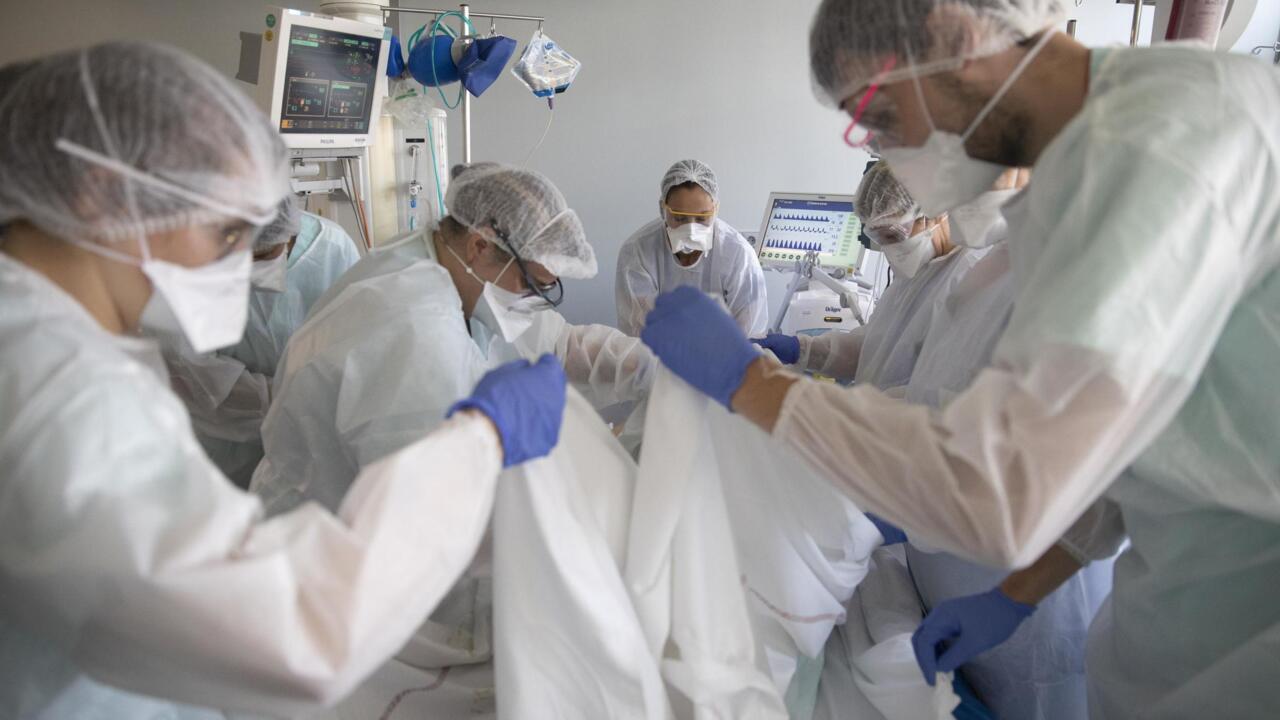What tools do doctors have to treat Covid-19?
Medical staff from Strasbourg hospital treat a patient with Covid-19 on September 15, 2020. AP Photo / Jean-Francois Badias
Text by: Simon Rozé Follow
6 min
A little over six months after the World Health Organization declared a state of pandemic, the wave of Covid-19 is still as virulent.
There will soon be 30 million cases worldwide and almost a million people have died.
Scientists and doctors know the disease better, but although the offer of care has evolved, there is still no “miracle” treatment.
Publicity
Read more
There are two ways to fight Covid-19: to attack Sars-CoV-2, the coronavirus that causes the disease, with the aim of removing it from the bodies of patients.
To achieve this, use the aptly named antivirals.
Unfortunately, none have proven effective today.
The other option is then to limit the damage caused by the virus.
They are of two types: those caused by Sars-CoV-2 when it "hijacks" the patient's cells to replicate there, and those caused by our immune system itself.
In severe forms, it happens indeed to the latter to get carried away and cause collateral damage, in the form of inflammation.
In the latter case, doctors are starting to have tools available.
"
These treatments make it possible to prevent the onset of inflammation which damages the lungs, heart and kidneys
", explains Pr Djillali Annane, head of the intensive medicine-intensive care unit at the AP-HP Raymond Poincaré hospital in Garches.
"
If we administer them in the more severe forms, they make it possible to limit it
".
The use of corticosteroids therefore has the double advantage of relieving severe cases and limiting the deterioration of the condition of less affected people.
The latter will therefore need to be admitted to the intensive care unit less often, thus limiting congestion, as we saw last spring in France.
Intubation still used
While it is difficult to predict how the epidemic will develop, the risk of saturation of intensive care services remains to be considered.
A limiting factor has only changed very little: the length of hospitalization.
It can reach several weeks or even more than a month for patients with a severe form of Covid-19, mechanically restricting the availability of beds.
This long duration is partly explained
by the intubation
and the need to place the patients in an artificial coma.
This very invasive and cumbersome procedure is in fact still used in the wards, even if we are now trying to limit it as much as possible.
“
A still large number of patients need to be intubated and placed in an artificial coma,
” says Professor Annane.
“
The severity of the cases has not diminished.
The virus has not lost its ability to harm the body: there is no virus today that is less dangerous.
We therefore expect to always have a large number of patients to intubate and to place in an artificial coma in order to be able to ensure correct oxygenation of their blood
”.
The effectiveness of anticoagulants
Oxygenation and corticosteroids are not, however, the only two weapons doctors have in the face of the coronavirus.
In addition to the damage caused by the coronavirus itself and inflammation, Covid-19 manifests itself through a third component: thromboembolic disease.
These are blood clots that form in the lungs.
Doctors therefore administer anticoagulants to prevent their formation.
“
All patients in intensive care in France
” receive it in a preventive manner according to Djillali Annane.
Until recently, however, very little data was available to assess their effectiveness.
These are however starting to be available.
Thus, a team from the Mount Sinai hospital in New York published in the
Journal of the American College of Cardiology
the results of a retrospective study concluding that
the anticoagulants administered in this context are effective.
Thus, this team observed that their preventive use was associated with a 50% reduction in the mortality of patients compared to those who did not receive them.
For the most severe cases, mortality was reduced by 47%.
The authors also underline that their use is also linked to less use of intubation.
These data, however, relate to only one study with a low level of evidence and therefore need to be confirmed and extended, but they are promising.
Our selection on the coronavirus
•
Listen to our
Coronavirus Info
column
•
Our
explanations
:
→
What are the persistent symptoms of Covid-19?
→
Young people and Covid-19
: health authorities concerned
→
Immunity to Covid-19 would be short-lived
→
Promising results for the vaccine against the coronavirus
•
How to make a mask and use it well
•
See also the
records
of
RFI Knowledge
on Covid-19
→
Birth of a pandemic
→
Daily proof
→
The history of epidemics
→
Science facing Covid-19
→
The geopolitical consequences
Newsletter
Receive all the international news directly in your mailbox
I subscribe
Follow all the international news by downloading the RFI application
google-play-badge_FR
Coronavirus
Health and medicine
On the same subject
AstraZeneca laboratory suspends clinical trial of its Covid-19 vaccine

